Theft has long been a craft for many. On police reports most often ...
|
|
In a modern house, you can’t do without plastic windows, but not for every style ... |
If your house like a palace has spacious large rooms with ceilings a meter high ... |
Lining carpet for tiles: installation features

With the proper use of the installation technology of the soft roof, the carpet is used under the soft tile to reliable protection of the structure from weather factors. The peculiarity of the technology in obtaining a reliable substrate that can simultaneously perform several functions, including compensation for the irregularities of the rafter surface, protection against water penetration and access of the extremely low temperature into the attic in the winter. A special carpet for tiles, recommended for all varieties of a soft roof, easily copes with these and other tasks.
Table of contents:
- Features and functional purpose of the carpet for soft roofing materials
- Varieties of lining carpets
- Self -adhesive lining carpet
- Varieties of the base for lining carpets
- Roof preparation for soft roof and stages of installation
Features and functional purpose of the carpet for soft roofing materials
In modern construction, a soft roof increasingly displaces traditional roofing materials. The new roof samples have great opportunities in the artistic and constructive sense, and in terms of reliability in operation.
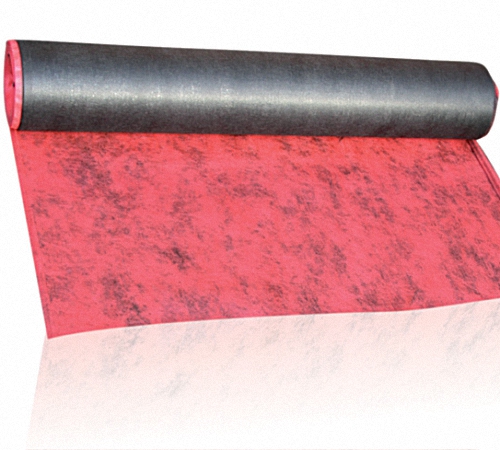
Modernized roofing materials are used without a rigid base, not counting the rafter system. But the lining carpet is required for soft tiles, otherwise all the irregularities in the design of the roof will appear. Keep in mind that the soft tile gives some shrinkage, but the finish form will be achieved only in natural conditions when exposed to precipitation and under the influence of temperature amplitude.
Lining carpet multilayer film coating:
- fiberglass at the base;
- bitumen polymer;
- fine crumb or sand on the outer layer;
- lower protective film and adhesive.
The lining carpet compensates for the changes in the roof level, and it is mounted in front of the flooring of soft roofing materials. However, he himself is quite reliable as a temporary roof, therefore, in the regions with a rainy climate, where there are few sunny days, first of all, they lay a lining layer to protect a new structure from leaks.
The lining carpet for tiles is available with some features for each manufacturer, but the classic soft roof sandwich has the following components:
- flexible tiles;
- lining carpet;
- oSB plate;
- waterproofing film;
- insulation;
- rafter system;
- vapor barrier film.
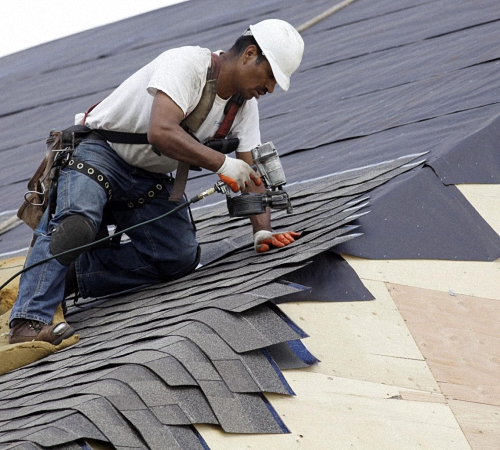
The lining carpet also helps to seal the joints between the two slopes of the roofs of a complex configuration, the arrangement of chimneys and the valleys. With such a reliable basis, one can not worry about an increased level of waterproofing, even in regions with complex climatic conditions with frequent oblique rain and impulsive wind of great power. The laying of the carpet under the soft tile also guarantees in the winter sufficient cushioning under a significant cap of snow on the roof.
The most practical varieties of lining roofing materials:
- fiberglass,
- polyester fabric.
The lining layer is a bitumen-polymer coating produced in the form of rolls. The lining carpet for soft tiles contains plasticizers, fibers and bitumen mastic to increase waterproofing and depreciation of the base. And to reduce sliding, the outer layer is treated with fine -grained sand or fine -fractional stone crumbs.
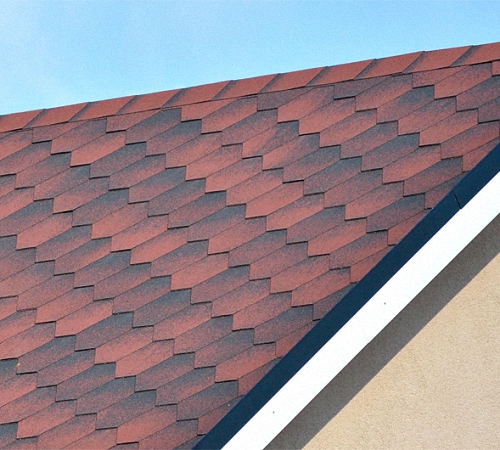
Attention: Remember that the lining carpet is mounted with a film down and the abrasive base upward (sprinkling with sand)! The seams are necessarily sealing, for example, with the help of bitumen mastic.
The lining carpet reliably protects the structural details of the roof, yendovs, a chimney hole, cornice overhangs from getting wet. They provide softer lines to all protruding and sharp elements of the roof. The main varieties of the lining carpet:
- on a self -adhesive basis;
- without self -adhesive.
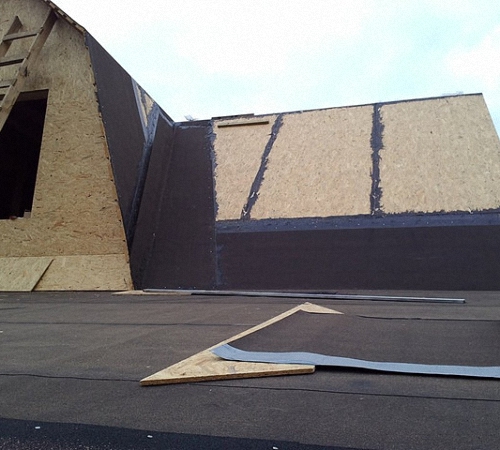
With a small slope of the roof slopes, the lining coating goes to the horse, yendov, ribs and around the perimeter. The lining carpet is covered with rolls from below with a small overlap, fixing the edges with roofing nails after about 20 cm. With a small roof slope, lining rolls are lined over the entire surface. Self -adhesive lining is conveniently installed, but additionally fastened with roofing nails. A carpet base without self -adhesive is fixed with a construction stapler or nails.
Depending on the shape of the roof, the panel is lined vertically or horizontally. At the same time, it is much more important that the lining carpet is normally pulled with a dense coat of the edge with mounting glue or mastic. If the roof is made under a large slope, then the rolls are much more convenient to lay vertically, and the folds are not formed.
Varieties of lining carpets
Most enterprises that have mastered the release of a flexible roof also produce a rolled lining carpet, which is necessary for such a coating. Multilayer material based on durable fiberglass or polyester is conveniently packaged on rolls no wider than 1m. The difference in the lining carpets is the method of fixing them.
1. A standard lining carpet without self -adhesive is fixed with roofing nails from galvanizing with a wide hat, a construction stapler is less common, and on the edges the material is joined with bitumen glue.
2. The combined type of lining carpets is fixed with nails, and the bottom has a self -adhesive strip with which it is easier to fix the edge of the canvas, and it is only necessary to remove the protective tape. Additional consolidation of nails in dubious places is not excluded.

3. Self -adhesive carpets are the most modern variety with the most convenient type of fixation. It is enough to correctly spread the canvas and remove the protective tape. Nails are used mainly only at the edges, and the stripes are securely fixed themselves. In cold weather, rolls are heated to improve fixation.
4. A fusible variety of lining carpets also requires warming up with a construction hairdryer for fixation. It is rarely used due to some inconvenience of using a hairdryer on the roof.
Note: each roll has an instruction for use, where all the recommendations for their laying, consumption and storage are clearly spelled out, according to standards.
Storage of lining rolls under a canopy, in the attic or in a closed room, at moderate temperature, that is, not higher than 30 ° C. If different types of lining carpets are used on one roof, then they are stored separately so as not to confuse and not rise to the roof once again. It is most convenient to put the rolls of the walls vertically. You cannot store it near heating devices and at high humidity. Keep in mind that on the roof in the summer they warm up much more, but there the lining carpet is used in the laid out and fixed form. He takes the excessive effect of sunlight on himself.

Self -adhesive lining carpet
The lining carpet is produced in rolons of 1x15 meters and is used when installing a soft roof for flexible tiles. The strengthening base is either fixed over the entire area of \u200b\u200bthe rafter system of the roof, or as a lining carpet under the bitumen tile at the joints or the most complex places of the structure. On sloping roofs, this layer is customary to be laid entirely, that is, throughout the area.
The rolls of the lining material are pulled, turning, parallel to the overhange over the cornice and pull to the skate with a small overlap, about 10 cm, fixing the edges with a stapler or roofing nails. For seams, the beam use the building glue K-36 or bitumen mastic. In the rolons on self -adhesive, the installation process is even simpler, thanks to the adhesive basis on the back.
Often, roller substrates are used only in the problem areas of the roof, those where the chimney pipe or the ventilation well comes out. The lining carpet is also lined fragmented where the end sections of the roof and attic windows converge.
This material is quite strong and durable in its impeccable operation, judging by the guarantees in the instructions, indicated from 15 to 25 years. The duration of its use without dismantling the roof depends on different factors:
- climatic factors;
- structural features of the roof;
- a method for installing a roll base;
- general load of a variety of flexible roof.
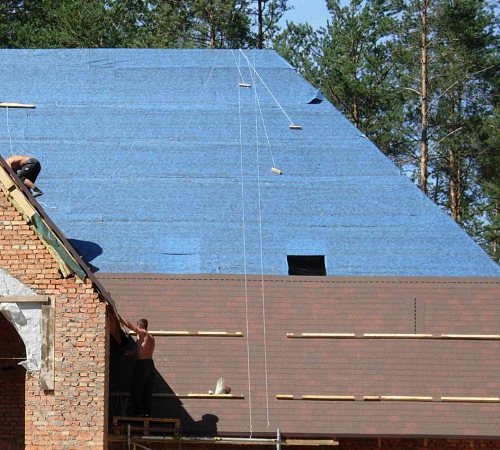
To protect the cut of the crate of the cornice overhang from the draining rain, it is recommended to mount droppers or special cornice from metal on top of the lining carpet. Metal fragments are fixed with a zigzag with roofing nails. On the edge, you can also use wind or pediment planks.
Before installing the lining carpet under the soft tile from the back surface, the protective film is carefully removed to open the self -adhesive. The roll is laid on top of the waterproofing film along the cornice overhangs along the perimeter of the roof. After fixing, the Stazz is mounted and cornice tiles in the joint with a small indent from the edge. This cornice tile is fixed with roofing nails to the crate so that a row of flexible tiles of the fasteners bloces.
Attention: when installing an ordinary flexible tile, it is important to monitor the shade of fragments so that the roof looks aesthetically pleasing. Check if there are sections of different shade or prophesh only light or dark ones. For this, experts recommend those who do not know how to lay a lining carpet under a soft tile, mix the roof elements from several packs. With non -compliance with the styling technology, there is a shift of the diagonal pattern typical of the roofing material.
Sometimes complex architecture and roof design leads to the fact that an additional layer of roller carpet in places of the most likely leak and at the joints of structural planes is required. When the yendov is provided in the roof design (the inner angle), the baked carpet begins to fix from here and is fixed with bitumen glue.
Installation of the lining canvas for flexible tiles around the chimney has its own characteristics. The basis must be cut smoothly along the skate line and reliably fixed with adhesive composition or roofing nails. On the other side of the ridge, the lining is cut off with a certain fiber on the finished part from the reverse side. Further, both parts of the canvas are reliably connected, for example, with bitumen mastic, and this is a reliable installation method. At the joints, around the chimney itself, it is additionally attached with wooden or metal strips around the perimeter.
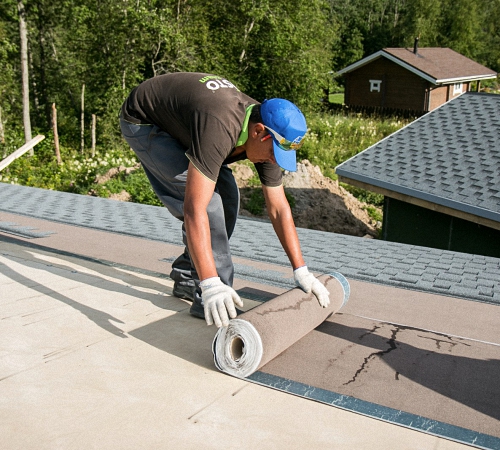
Varieties of the base for lining carpets
1. Moisture -resistant plywood widespread multilayer building materials, where wood sheets are treated with opposing moisture with a composition. It is a little more expensive than a tree due to large expenses in time during its manufacture. With a clear advantage of its surface, plywood does not belong to particularly durable materials. And although the upper layer will be protected by a sealed lining carpet, the temperature difference is regularly felt from the inside. The thicker the plywood on the roof, the longer it will last without complaints.
2. The natural board is the most affordable and popular building materials, which, due to its natural structure, has disadvantages. This is probable as the difference in width at the beginning and end of the board. It is heavy and uncomfortable for installation, especially if the boards are long. And increased humidity can change the geometry of the board, which is already not accurate. Nevertheless, with reliable fixing, the deformation of the board is unlikely, but the nails can split it during installation.
3. A oriented-brown plate (OSP or OSB) is available on the basis of an elongated chip, which is laid out, glued and compressed using a special technology. It is quite moisture resistant and reliable and least susceptible to deformations. Nails do not damage OSB slabs, even when it hits the edge. For a roof, it is better to take plates with a thickness of about 1 cm.

Roof preparation for soft roof and stages of installation
1. Before laying the lining carpet under a flexible tile, it is important to make sure that the base is even and continuous. Rolled and piece materials will be fixed on this solid basis.
2. It is not recommended to use wet or low -quality material. A figurative board, moisture-resistant plywood or OSP (OSB) plate with a minimum humidity indicator of 16-20%is suitable.
3. Plates or boards should be associated on supports or rafters. It is advisable to use boards of such a length that they pass at least 2 supports.
Attention: Remember the direction of wood fibers and the expansion of the boards, they should alternate. A small gap is left between the boards, which minimizes the loads when they are expanded from increased humidity.
4. Rolled material is selected depending on what type of soft roof preferred. The installation instructions will indicate all the parameters for the choice of the lining carpet and glue (nails).
5. The first board is laid from below, parallel to the cornice to work from the bottom up and wake up the moisture drain. The edges must be additionally fixed with roofing nails, even if it is self -adhesive, the seams should be sealed.

6. Do not forget about reliable waterproofing:
- at the ends;
- on the skate;
- in the valleys;
- at the chimney;
- at the joints against the wall;
- on the attic windows.
Tip: Do not save on roofing building materials, especially when it comes from modern aesthetic varieties of a soft roof. Not only the general view of the house depends on this, but also the protection against the flow and the comfort of all living in it.
A good base is cheaper than periodic refinement and forced annual repairs in order to eliminate previous shortcomings. Look about the lining carpet under the soft tiled video.
